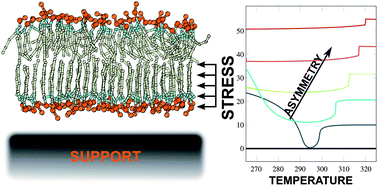Freezing of stressed bilayers and vesicles†
Abstract
We show using a minimalistic theoretical framework that phase transition decoupling in lipid bilayers is caused by a nonuniform stress profile due to an asymmetric distribution of lipids between the two leaflets. Applying this framework to vesicles, we demonstrate that their anomalous freezing is also caused by a stress asymmetry, but that this is due to lipid tail extension on freezing. Finally, we predict a previously unknown dependence of surface tension on temperature, find the phenomenon also in coarse grained molecular dynamics simulations, and suggest that it might have relevance in thermosensitive protein gating.


 Please wait while we load your content...
Please wait while we load your content...